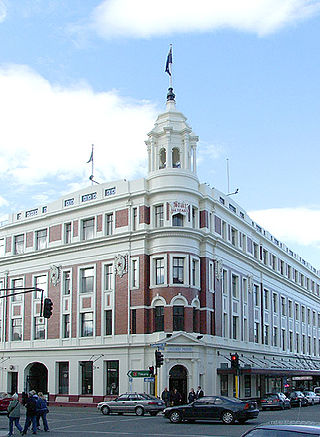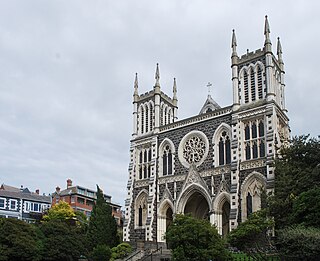
The Otago Daily Times (ODT) is a newspaper published by Allied Press Ltd in Dunedin, New Zealand. The ODT is one of the country's four main daily newspapers, serving the southern South Island with a circulation of around 26,000 and a combined print and digital annual audience of 304,000. Founded in 1861 it is New Zealand's oldest surviving daily newspaper – Christchurch's The Press, six months older, was a weekly paper until March 1863.

Otago Polytechnic is a public New Zealand tertiary education institute, centred in Dunedin with additional campuses in Cromwell and Auckland. Otago Polytechnic provides career-focused education and training, offering a range of New Zealand accredited postgraduate qualifications, degrees, diplomas and certificates at levels 2–10. In November 2022, it became a business unit of the national mega polytechnic Te Pūkenga, ending its existence as an independent entity.

Robert Arthur Lawson was one of New Zealand's pre-eminent 19th century architects. The Dictionary of New Zealand Biography states that he did more than any other designer to shape the face of the Victorian era architecture of the city of Dunedin. He is the architect of over forty churches, including Dunedin's First Church for which he is best remembered, but also other buildings, such as Larnach Castle, a country house, with which he is also associated.
The New Zealand and South Seas International Exhibition was a world's fair held in Dunedin, New Zealand, from 17 November 1925 until 1 May 1926, which celebrated that country and the South Seas. It was the third such exhibition held in Dunedin, with earlier exhibitions in 1865 and 1889. The exhibition had over 3 million visitors. It had added a new 'Special Exhibits' section focusing on art and craftwork made by women, a breakthrough that lifted the profile of women's art and craftwork.

St Joseph's Cathedral is the cathedral for the Roman Catholic Diocese of Dunedin. It is located in City Rise in the city of Dunedin, New Zealand. It serves as the seat of the bishop of the Latin Church Diocese of Dunedin, which was erected on 26 November 1869.

David Pinkerton was a New Zealand Member of Parliament for Dunedin City, in the South Island.

Caversham is one of the older suburbs (neighbourhoods) of the city of Dunedin, in New Zealand's South Island. It is sited at the western edge of the city's central plain at the mouth of the steep Caversham Valley, which rises to the saddle of Lookout Point. Major road and rail routes south lie nearby; the South Island Main Trunk railway runs through the suburb, and a bypass skirts its main retail area, connecting Dunedin's one-way street system with the Dunedin Southern Motorway. The suburb is linked by several bus routes to its neighbouring suburbs and central Dunedin.
Albert John Turnbull was a New Zealand cricketer who played a single first-class match for Otago during the 1896–97 season.
Leonard Montague Harris was an Australian-born cricketer. He played first-class cricket in New Zealand for Otago and Wellington between the 1881–82 and 1893–94 seasons.

Choie Sew Hoy also known as Charles Sew Hoy was a New Zealand merchant, Chinese leader, gold-dredger and a New Zealand Business Hall of Fame laureate. He was born in the village of Sha Kong in the Poon Yu District of Guangdong Province, China in about 1838.

Alfred Lee Smith was a Yorkshire-born businessman from Dunedin, New Zealand. He was a member of the member of the New Zealand Legislative Council for one term from 1898 to 1905.
Joseph Barnes Borton was a New Zealand goldfields warden and cricketer. Along with William Gilbert Rees, Gibson Turton, James Fulton, and Herbert Kissling, he is credited with reviving interest in cricket in Otago in the 1860s.
Daniel Patrick Claffey was a New Zealand sportsman. He played two first-class cricket matches for Otago, one in each of the 1888–89 and 1889–90 seasons, and played provincial rugby union for the Otago side.
Allen Clyde Holden was a New Zealand cricketer. He played two first-class matches for Otago, one in each of the 1937–38 and 1939–40 seasons.
Arthur Edmund Symonds was a New Zealand sportsman. He played one first-class match for Otago during the 1926–27 season.

Surefoot was a British Thoroughbred racehorse and sire whose exceptional racing ability was combined with a violent and unpredictable temperament. As a juvenile in 1889 he was regarded as the best colt of his generation in England after winning three of his four races including the Woodcote Stakes and New Stakes. He also demonstrated his precocity by reportedly siring a foal as a two-year-old. In 1890 he was an emphatic winner of the 2000 Guineas but despite being regarded as a near certainty for the Epsom Derby he finished fourth after spending much of the race attempting to savage other horses and jockeys. He went on to win a minor race at Royal Ascot and later defeated a strong field to take the valuable Prince of Wales' Stakes at Leicester Racecourse. As a four-year-old he showed little worthwhile form early in the season but returned to his best to win the Eclipse Stakes. After his retirement from racing he stood as a breeding stallion in England and France but had limited success as a sire of winners.
Semolina was a British Thoroughbred racehorse and broodmare. Bred and owned by the 6th Duke of Portland, she was one of the best two-year-olds in England in 1889 when she won thirteen times from fifteen races. In the following spring she recorded her biggest success when she won the 1000 Guineas. She went on to run fourth in the Oaks Stakes and third in the Coronation Stakes, but never won again and was retired from racing at the end of the year. She had modest success as a dam of winners.
Lily Attey Daff was a British-born designer and artist who worked in New Zealand and published watercolour paintings and line drawings of many native New Zealand birds and flowers.
The Colonial Bank of New Zealand was a trading bank headquartered in Dunedin, New Zealand which operated independently for more than 20 years. A public company listed on the local stock exchanges it was owned and controlled by New Zealand entrepreneurs and not London or Australian bankers. Still subject to the same vicissitudes as its fellow colonial banks it was bought by the Bank of New Zealand in 1895.

Dunedin Symphony Orchestra is a professional symphony orchestra based in Dunedin, New Zealand. It hosts an annual subscription series of concerts in the Dunedin Town Hall, performing repertoire from the Classical, Romantic and contemporary periods. It also regularly accompanies Dunedin stage performances by the Royal New Zealand Ballet, Opera Otago and City Choir Dunedin.












